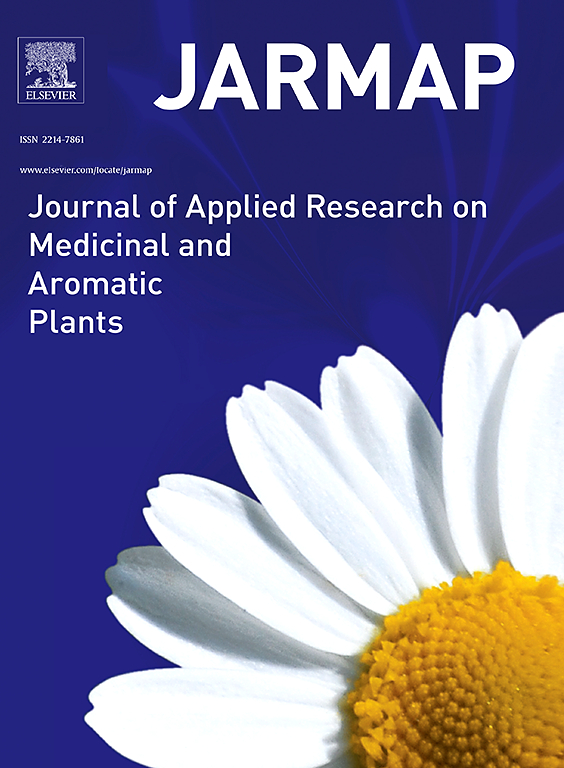Using microwave-assisted extraction with advanced artificial intelligence models for predicting tannins in black pepper (Piper nigrum L.)
IF 3.6
2区 农林科学
Q1 PLANT SCIENCES
Journal of Applied Research on Medicinal and Aromatic Plants
Pub Date : 2025-02-01
DOI:10.1016/j.jarmap.2024.100594
引用次数: 0
Abstract
Black pepper (Piper nigrum L.) is a widely used spice that provides great potential for research in the field of natural products. In this work, the recovery of tannins from black pepper was conducted using microwave-assisted extraction (MAE). The study involves four independent variables: power (from 100 to 300 W), extraction time (from 10 to 40 minutes), temperature (from 35 to 50 °C), and the ratio of food to solvent (from 0.25 to 0.5 g/10 mL). The response variable was the extraction yield, which is the total tannin content. A total of 30 different experimental runs were completed in the MAE system. An evaluation and comparison of two non-verbal modeling approaches and artificial intelligence-based models was conducted. In order to predict design performance and results, the three SVR-RSM, M5Tree, and RM5Tree models were compared to a proposed nonlinear regression model. Evaluations were conducted using health criteria such as RMSE and NSE. With an RMSE of 0.035 and an NSE of 0.91, the SVR-RSM algorithm showed the highest level of accuracy. A RMSE of 0.048 and an NSE of 0.83 is obtained from the RM5tree model, while a RMSE of 0.055 and an NSE of 0.78 is obtained from the M5Tree model. Also, an NSE of 0.65 and a RMSE of 0.068 were obtained for the proposed nonlinear model. The SVR-RSM algorithm had maximum accuracy, but tree models for systems requiring a quick response are the right options. Using the proposed non-error model, complex relationships between variables could also be modeled.
微波辅助提取与先进人工智能模型预测黑胡椒(Piper nigrum L.)单宁含量
黑胡椒(Piper nigrum L.)是一种应用广泛的香料,在天然产物领域具有很大的研究潜力。采用微波辅助萃取法从黑胡椒中提取单宁。该研究涉及四个自变量:功率(从100到300 W),提取时间(从10到40 分钟),温度(从35到50°C),以及食物与溶剂的比例(从0.25到0.5 g/10 mL)。响应变量为提取率,即总单宁含量。在MAE系统中共完成了30次不同的实验运行。对两种非语言建模方法和基于人工智能的模型进行了评价和比较。为了预测设计性能和结果,将SVR-RSM、M5Tree和RM5Tree三种模型与提出的非线性回归模型进行了比较。使用RMSE和NSE等健康标准进行评估。SVR-RSM算法的RMSE为0.035,NSE为0.91,显示出最高的精度。RM5tree模型的RMSE为0.048,NSE为0.83,而M5Tree模型的RMSE为0.055,NSE为0.78。该模型的NSE为0.65,RMSE为0.068。SVR-RSM算法具有最高的精度,但对于需要快速响应的系统,树模型是正确的选择。利用提出的非误差模型,变量之间的复杂关系也可以建模。
本文章由计算机程序翻译,如有差异,请以英文原文为准。
求助全文
约1分钟内获得全文
求助全文
来源期刊

Journal of Applied Research on Medicinal and Aromatic Plants
Pharmacology, Toxicology and Pharmaceutics-Drug Discovery
CiteScore
6.40
自引率
7.70%
发文量
80
审稿时长
41 days
期刊介绍:
JARMAP is a peer reviewed and multidisciplinary communication platform, covering all aspects of the raw material supply chain of medicinal and aromatic plants. JARMAP aims to improve production of tailor made commodities by addressing the various requirements of manufacturers of herbal medicines, herbal teas, seasoning herbs, food and feed supplements and cosmetics. JARMAP covers research on genetic resources, breeding, wild-collection, domestication, propagation, cultivation, phytopathology and plant protection, mechanization, conservation, processing, quality assurance, analytics and economics. JARMAP publishes reviews, original research articles and short communications related to research.
 求助内容:
求助内容: 应助结果提醒方式:
应助结果提醒方式:


